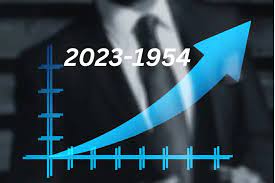2023-1954
Exploring the Passage of Time: From 1954 to 2023

From 2023-1954, over seven decades of human history will have passed, filled with notable events, dramatic shifts, and the development of societies. In this investigation, we examine the significant turning points, cultural transformations, and noteworthy discoveries that have molded the globe over these years, considering the passage of time and its effects on civilization.
The Era of Post-War Reconstruction (1954-1969)
Post-War Rebuilding Efforts:
The years 2023-1954 were marked by significant attempts to reconstruct war-torn countries and bring stability to ravaged areas following World War II. Initiated in 1948, the Marshall Plan was instrumental in promoting economic recovery, easing the reconstruction of Europe, and creating the foundation for a new era of prosperity.
Cold War Tensions:
Higher levels of hostility between the US and the USSR characterized the years 1954 to 1969, which contributed to the Cold War’s outbreak. The 1962 Cuban Missile Crisis highlighted the dangers of geopolitical brinkmanship and ideological rivalry by bringing the world dangerously close to nuclear war.
Technological Advancements:
Significant technological developments during the 2023-1954 changed daily life and the world economy. Innovation drove advancement and ushered in a new period of scientific discovery, from the introduction of television and the spread of consumer electronics to the launch of Sputnik in 1957 and the beginning of the space age.
The Cultural Revolution of the 1960s and 1970s
Social Movements:
A surge of social and cultural movements that questioned prevailing conventions and institutions defined the 1960s and 1970s. Activism and dissent changed the political and social environment, from the battle for gender equality and civil rights to the anti-war demonstrations and the rise of countercultural movements.
Cultural Icons:
Iconic people from the 1960s and 1970s made a lasting impression on society and popular culture. The era was characterized by artistic ferment and cultural energy, from the musical revolution led by groups like The Beatles and The Rolling Stones to the emergence of significant voices in literature, film, and other media.
Technological Revolution:
The digital era began in the 1960s and 1970s with the creation of the fundamental technologies that would transform computing, information technology, and communication. The personal computer revolution changed how people worked, interacted, and communicated once the microprocessor was invented in 1971.
Globalization and Technological Innovation (1980s-1990s)
Economic Liberalization:
As countries embraced free-market ideals and removed trade obstacles, globalization and economic liberalization proliferated in the 1980s and 1990s. The Cold War period came to an end with the fall of the Soviet Union in 1991, and a new one of economic integration and interconnection was born.
Information Age:
The Information Age began with the development of the internet in the latter half of the 20th century, which completely changed how people shared, accessed, and distributed information. When it was first introduced in 1991, the World Wide Web enabled unprecedented worldwide interconnectedness and democratized access to knowledge.
Technological Innovation:
Rapid technical innovation occurred in a number of industries during the 1980s and 1990s, including biotechnology, telecommunications, aerospace, and transportation. Innovations like the Human Genome Project, the creation of cell phones, and the business of space exploration changed industries and raised the bar for human potential.
The 21st Century: Challenges and Opportunities
Globalization and Inequality:
Globalization and growing inequality have been the two main trends of the early 21st century, as economic gaps both inside and between countries increase. The spread of digital technologies has made it easier for capital, goods, and information to move around the world, but it has also made social and economic divides worse.
Environmental Concerns:
The urgency of addressing climate change and environmental sustainability have also received more emphasis in the twenty-first century. Environmental issues represent existential hazards to the planet and future generations, ranging from extreme weather occurrences and natural disasters to biodiversity loss and resource depletion.
Technological Disruption:
An age of unparalleled change and disruption has begun in the 21st century due to the high speed of technological progress. Emerging technologies, which include blockchain, virtual reality, and artificial intelligence and automation, have the power to completely change economies, industries, and even the definition of labor and human existence.
Conclusion
Between 2023-1954, there have been a lot of important events, major shifts in society, and deep transformations. The trip through history illustrates the human capacity for resiliency, creativity, and inventiveness in the face of hardship and change, from the wake of World War II and the emergence of the digital age to the potential and challenges of the twenty-first century. We are constantly reminded of the value of empathy, teamwork, and collective action as we work to create a more just, sustainable, and inclusive future for all as we negotiate the complexity of today’s world.
-

 Sports5 months ago
Sports5 months agoTaraftarium24 Kralbozguncu: A Comprehensive Review of Live Sports Streaming Platforms
-

 Biography4 months ago
Biography4 months agowhatutalkingboutwillistyle the lifestyle
-

 Entertainment5 months ago
Entertainment5 months agoRepelis24: Redefining Online Movie Streaming with a Wealth of Content
-

 Sports4 months ago
Sports4 months agoCanlı maç izle
-

 HEALTH7 months ago
HEALTH7 months agoWellhealth Organic Home Remedies Tag: Explore Health Benefits
-

 Entertainment4 months ago
Entertainment4 months agoJojobet TV
-

 FOOD6 months ago
FOOD6 months agoMaslaaseen: Embracing Diversity and Unity
-

 Sports4 months ago
Sports4 months agoMatbet TV APK
